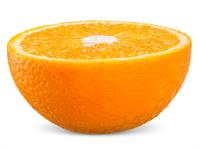PDF chapter test TRY NOW
1. The diameter of an orange is 8 \ cm. Calculate the total surface area of the half orange.

Solution:
Diameter of an orange, d = 8 \ cm
Radius of an orange, r =
A half orange is in the shape of a hemisphere.
Total surface area of a hemisphere = 3 \pi r^2 sq. units
=
=
= 150.86
The total surface area of the half orange is 150.86 \ cm^2.
2. If the inner and outer radius of the hemispherical shell is 3 \ cm and 5 \ cm, find the thickness and the curved surface area of the shell.
Solution:
Inner radius, r = 3 \ cm
Outer radius, R = 5 \ cm
Thickness = R - r
= 5 - 3 = 2
The thickness of the shell is 2 \ cm.
Curved surface area = 2 \pi (R^2 + r^2) sq. units
=
=
=
= 213.7
The curved surface area of the hemispherical shell is 213.7 cm^2.
Important!
The value of \pi should be taken as \frac{22}{7} unless its value is shared in the problem.
